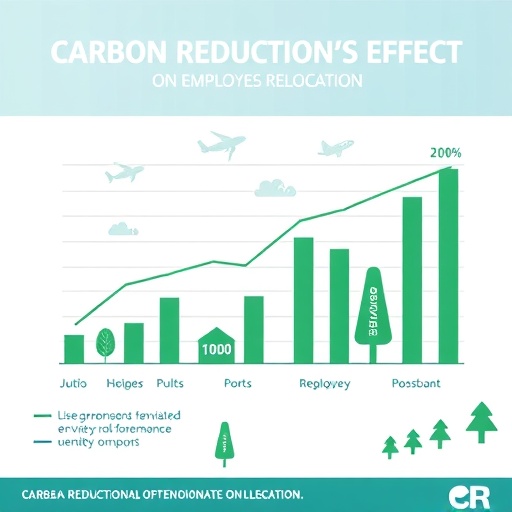In a groundbreaking study recently published in Humanities and Social Sciences Communications, researchers Xuemei H., Ali S., and Bilal H. have meticulously investigated the impact of carbon reduction initiatives on employee relocation decisions. This research stands out not only for its innovative thematic focus but also for its rigorous methodological approach, which robustly demonstrates the validity of the proposed theoretical framework vis-à-vis the data analyzed.
The study’s authors employed advanced statistical modeling techniques, placing particular emphasis on the Root Mean Square Error of Approximation (RMSEA) as a primary metric to assess model fit. Notably, the independence model—used as a baseline comparison—exhibited an RMSEA of 0.83177. This figure is alarmingly high, significantly exceeding the conventional thresholds for acceptable fit, thereby highlighting an unsatisfactory representation of the underlying data structure when relationships among variables are disregarded.
To delve further into model reliability, confidence intervals offer deeper insight. The 90% confidence interval of the RMSEA for the independence model fell between 0.78975 and 0.87457. Such a narrow range, entirely above acceptable limits, reaffirms the poor performance of this simplistic model and indicates a consistent lack of fit across possible sampled populations. Moreover, the PCLOSE test—used to evaluate the null hypothesis that RMSEA is below 0.05—yielded a p-value of 0.00000, effectively ruling out any chance that this model adequately fits the empirical data.
Against this stark backdrop of inadequate baseline model performance, the researchers contrast their carefully specified, theoretically driven proposed model. The markedly poorer fit of the independence model underscores the proposed model’s superiority in capturing the complex interrelationships among variables critical to understanding employee relocation patterns amid environmental policy shifts.
Complementing the RMSEA analysis, Xuemei and colleagues also leveraged the Expected Cross-Validation Index (ECVI), a metric designed to evaluate how well a model predicts future or independent datasets. The results further bolstered confidence in the proposed framework. The default and saturated models shared identical ECVI values of 0.02390, with an exceptionally narrow 90% confidence interval positioned sharply around these values. This near-perfect correspondence indicates a model that not only fits the current data but also remains robust in predictive generalizability.
The Modified Expected Cross-Validation Index (MECVI), a stricter variant of ECVI, similarly reflected exemplary fit, registering a value of 0.02410. These low and consistent ECVI and MECVI values indicate that the proposed models possess excellent predictive accuracy, operating with reliability and stability sufficient to warrant broader application in related contexts.
In stark contrast, the independence model’s ECVI measured a strikingly higher 2.09343, accompanied by a broad 90% confidence interval spanning from 1.88903 to 2.31254. This vast disparity highlights the independence model’s inherent limitations in predictive performance, thereby underscoring the indispensable role of modeling inter-variable relationships to capture the complexities of employee relocation under carbon reduction pressures.
These comparative analyses collectively build a compelling evidentiary case for the validity and usefulness of the researchers’ comprehensive model. The default and saturated models’ superior statistical fit metrics manifest the nuanced connections between variables linked to carbon initiatives’ influence on relocation decisions, offering critical insight unavailable through simplistic modeling alternatives.
Beyond statistical prowess, the research carries profound implications for corporate policy formation and environmental strategy. By portraying how decarbonization efforts tangibly influence workforce mobility, the study equips organizational leaders with data-driven frameworks to anticipate and manage relocation trends more effectively while aligning with broader sustainability goals.
Moreover, the study’s methodological rigor sets a benchmark for future inquiries into environmental economics, labor mobility, and organizational behavior. The meticulous verification against stringent fit criteria ensures confidence in interpreting parametric estimates and structural relationships defining this emergent research domain.
The findings advocate for integrated analytical approaches that embrace complexity rather than oversimplified independence assumptions, which can mask critical dynamics. This stance is pivotal when addressing multifaceted societal challenges such as sustainable urban development, climate adaptation, and workforce planning in a rapidly evolving economic landscape.
In light of these insights, stakeholders across academia, industry, and public policy stand to benefit significantly from the adoption of validated models like this one. Policies informed by such robust frameworks can better accommodate shifting employee preferences prompted by environmental imperatives and logistical constraints inherent in relocation decisions.
As global climate commitments intensify, understanding the behavioral and organizational repercussions of carbon reduction initiatives gains heightened urgency. This study contributes foundational knowledge by elucidating these mechanisms through advanced analytical lenses that marry statistical rigor with environmental relevance.
Ultimately, this research embodies how empirical sophistication and societal relevance can coalesce to produce actionable intelligence. It heralds a new era where quantitative modeling not only tests hypotheses but also informs transformative practice addressing the interconnected challenges of today’s socio-environmental milieu.
Future research will likely expand upon these findings by exploring longitudinal scenarios, varied cultural contexts, and sector-specific dynamics. This continued exploration promises deeper understanding and refinement, aiding sustainable transitions aligned with human and planetary wellbeing.
In sum, the exemplary research by Xuemei, Ali, and Bilal charts an inspiring path forward. It exemplifies the power of combining robust empirical methods with pressing contemporary problems, yielding insights poised to resonate widely and influence diverse spheres engaged in building a sustainable future.
Subject of Research: Impact of carbon reduction initiatives on employee relocation decisions.
Article Title: Carbon reduction initiatives impact on the employee relocation.
Article References:
Xuemei, H., Ali, S. & Bilal, H. Carbon reduction initiatives impact on the employee relocation. Humanit Soc Sci Commun 12, 1502 (2025). https://doi.org/10.1057/s41599-025-05756-1
Image Credits: AI Generated




